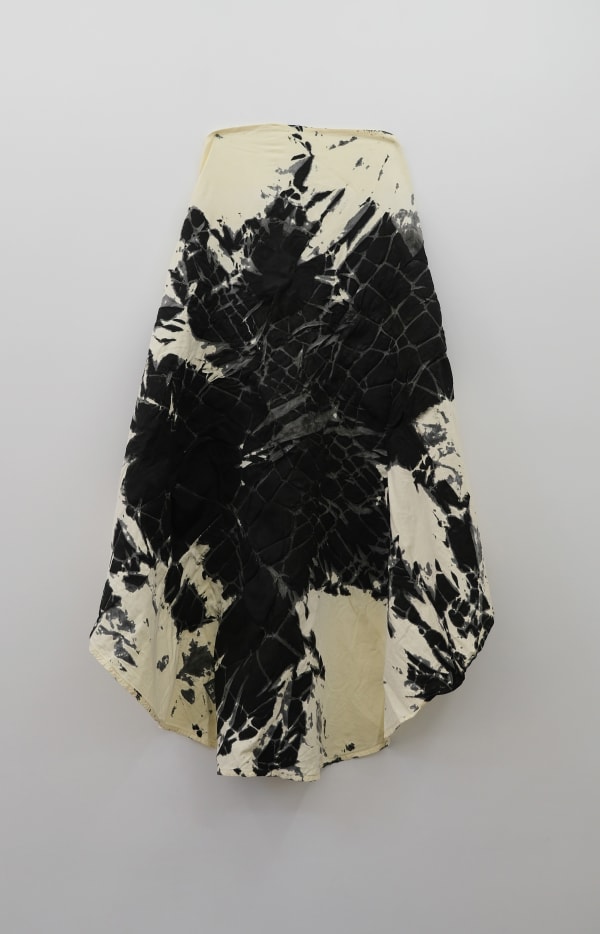The path guides the meaning
As our lives are increasingly consumed and our actions dictated by mediated experiences, dominated by screens, regulated by algorithmic determinacy, and divorced from the physicality of our world, the work of artists engaged in process-based practices remind us of the importance of making and doing as a pathway to meaning, learning, and growth. Favoring fluidity, collaboration, and collective work, the eight artists included in The path guides the meaning see opportunities in the everyday – relying upon quotidian materials and processes – and thoughtful collaboration with people in their communities. They produce works that challenge our contemporary tendency towards isolation and the technologically prescribed, foregrounding communal and shared experiences. In so doing, they pursue new forms of engagement with the world around us.
Achraf Touloub traffics in resistance, recoiling from legibility and categorization. Touloub’s paintings engage viewers in visual exercises where hazy paintings vibrate with color rather than cohere or coalesce. This insistence on fluidity and disengagement with fixity is a shared trait for Kate Newby and ektor garcia who repurpose materials and deconstruct works from their own oeuvre to create new sculptural objects and installations. Both artists also rely upon community collaboration and the body as both tool and form. A cascade of tiles made by shaping clay slabs onto Newby’s forearms climb the wall in The path guides themeaning, echoing the architectural features of the gallery while also referring to the “bones” of the building and the artist’s own body. garcia’s lacey, copper screen, crochet copper wire mesh (2021), a highly worked object made by an intricate process of twisting and shaping copper wire, references dualities: labor and time; permeability and porosity; strength and vulnerability. Carmen Argote’s Arrangement of Wares (2017) also refers to movement and temporality: the structures and choreography of our everyday routines such as brewing and drinking coffee, but also the time it takes to grow and harvest this ubiquitous commodity, and the labor implied therein. The marks on the paper support are coffee stains; the result of a repetitive action and remnants of the artist’s process. Maia Ruth Lee’s Domestic Bondage Baggage (2022) also gestures to the routines of everyday life – to domestic spaces and the repetitive actions that transpire within them. The first object in Lee’s Bondage Baggage series, a circular, standard-size tablecloth holds the traces of lattice-like bindings. Sisters and collaborators Janelle and Lisa Iglesias, who work together as Las Hermanas Iglesias, have a shared practice that revels in play, openness, and chance, and more recently, on their roles as caregivers. To create Fluffed Loomed and Twin Peaked (2016–22) the sisters mailed a found textile back and forth across the country, altering it over a period of several years. Casts of their mother’s hands hold the textile in position. Sahar Khoury’s use of found materials and emphasis on recuperation or reactivation relies upon moments of juxtaposition. In Untitled (cage with handles and belts) (2019) structures of containment—belts and other connectors compressand hold the work together—echoing the forms of containment and porosity visible in garcia’s screens and Lee’s carefully rendered tracings.
The exhibition concludes with a new performance (31 August, 6pm) by Carolyn Pennypacker Riggs entitled O Virgos Splendens. Riggs’ practice encompasses voice, music, scent, and performance with an ever-evolving community of collaborators.
Curated by MacKenzie Stevens
-
 Carmen Argote, Arrangement of Wares (Full), 2017
Carmen Argote, Arrangement of Wares (Full), 2017 -
 Kate Newby, i could listen all day, 2023
Kate Newby, i could listen all day, 2023 -
 Kate Newby, Lasting Sounds, 2022
Kate Newby, Lasting Sounds, 2022 -
 ektor garcia, crochet copper wire mesh, 2021
ektor garcia, crochet copper wire mesh, 2021 -
 Las Hermanas Iglesias, Fluff Loomed and Twin Peaked, 2016–2022
Las Hermanas Iglesias, Fluff Loomed and Twin Peaked, 2016–2022 -
 Sahar Khoury, Untitled (cage with handles and belts), 2019
Sahar Khoury, Untitled (cage with handles and belts), 2019 -
 Maia Ruth Lee, Domestic Bondage Baggage, 2022
Maia Ruth Lee, Domestic Bondage Baggage, 2022 -
 Achraf Touloub, Untitled, 2023
Achraf Touloub, Untitled, 2023 -
 Achraf Touloub, Untitled, 2023
Achraf Touloub, Untitled, 2023


















